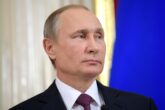April 23, 2024
The Axis of Upheaval
How America’s Adversaries Are Uniting to Overturn the Global Order
In the early morning of January 2, Russian forces launched a massive missile attack on the Ukrainian cities of Kyiv and Kharkiv that killed at least five civilians, injured more than 100, and damaged infrastructure. The incident was notable not just for the harm it caused but also because it showed that Russia was not alone in its fight. The Russian attack that day was carried out with weapons fitted with technology from China, missiles from North Korea, and drones from Iran. Over the past two years, all three countries have become critical enablers of Moscow’s war machine in Ukraine.
The West has been too quick to dismiss the coordination among China, Iran, North Korea, and Russia.
Since Russia’s invasion in February 2022, Moscow has deployed more than 3,700 Iranian-designed drones. Russia now produces at least 330 on its own each month and is collaborating with Iran on plans to build a new drone factory inside Russia that will boost these numbers. North Korea has sent Russia ballistic missiles and more than 2.5 million rounds of ammunition, just as Ukrainian stockpiles have dwindled. China, for its part, has become Russia’s most important lifeline. Beijing has ramped up its purchase of Russian oil and gas, putting billions of dollars into Moscow’s coffers. Just as significantly, China provides vast amounts of warfighting technology, from semiconductors and electronic devices to radar- and communications-jamming equipment and jet-fighter parts. Customs records show that despite Western trade sanctions, Russia’s imports of computer chips and chip components have been steadily rising toward prewar levels. More than half of these goods come from China.
The support from China, Iran, and North Korea has strengthened Russia’s position on the battlefield, undermined Western attempts to isolate Moscow, and harmed Ukraine. This collaboration, however, is just the tip of the iceberg. Cooperation among the four countries was expanding before 2022, but the war has accelerated their deepening economic, military, political, and technological ties. The four powers increasingly identify common interests, match up their rhetoric, and coordinate their military and diplomatic activities. Their convergence is creating a new axis of upheaval—a development that is fundamentally altering the geopolitical landscape.
Read the full article from Foreign Affairs.
This expert commentary is part of High Stakes: Preparing the Next President, a new election-year initiative to explore the most pressing national security issues that will face a new administration. As part of this new center-wide series, CNAS will develop a targeted collection of resources to help the candidates, policy makers and their teams prepare for the new presidential term that begins in January 2025.
More from CNAS
-
The Eurasian Century: Hot Wars, Cold Wars, and the Making of the Modern World with Hal Brands
For more than 100 years, the continent of Eurasia has played a central role in global geopolitics. In the 20th century, numerous authoritarian powers from Germany under Kaiser...
By Andrea Kendall-Taylor, Jim Townsend & Hal Brands
-
Putin’s Fight Won’t End With Ukraine
In an essay for Foreign Affairs, titled “Putin’s Point of No Return,” Andrea Kendall-Taylor, senior fellow and director of the Transatlantic Security Program at the Center for...
By Andrea Kendall-Taylor
-
Trump’s Callout of Russia’s Vladimir Putin Is Raising Eyebrows
President Trump is threatening sanctions and tariffs on Russia if Putin doesn't reach an agreement to end the war in Ukraine. Some are surprised, considering Trump's affinity ...
By Andrea Kendall-Taylor
-
In Russia's Perceived War with the West, Arms Control is Collateral Damage
Russia seemingly perceives previously established arms control agreements as elements of the broader Western-dominated political and security order that it aims to overturn....
By Nicholas Lokker




